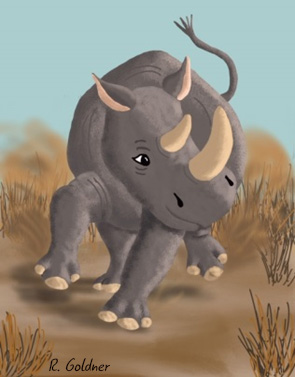Black Rhinoceros
by Rita Goldner
Today, October 1, is the anniversary of our Authors Group Blog. Welcome to the fourth  year of daily blogs from authors about a kaleidoscope of topics. I kicked off the series, because I wanted the blog group’s anniversary to coincide with my birthday, and here I am, four years later, celebrating both!
year of daily blogs from authors about a kaleidoscope of topics. I kicked off the series, because I wanted the blog group’s anniversary to coincide with my birthday, and here I am, four years later, celebrating both!
One important thing I’ve learned so far in my short writing career is to be true to myself, especially in the choice and presentation of subject matter. I’m both a writer and an illustrator, but the drawing is more fun for me. I have to work harder at the writing. I recently confronted a dilemma concerning my work-in-progress, Rhonda’s Big Feet, a picture book about a rhinoceros. Since I’m passionate about endangered species, I initially chose a Sumatran rhino for my protagonist, since they’re critically endangered, facing extinction. There are five different kinds of rhinos, and here’s how many are left of each:
| Javan | 67 |
| Sumatran | 80 |
| Black | ≈5,300 |
| Greater One-Horned | 3,500 |
| White | 20,000 |
They’re all in trouble, but some are worse off than others.
I had finished the story, but when I started the drawings I realized that the Sumatran rhino had short stubby horns, and a smaller body size. Nowhere near as impressive as a huge black rhino, with two magnificent pointy horns. If I wanted to depict my protagonist thundering across the grassland in pursuit of a predator, my obvious choice was a black rhino. This means I have to go back and change the co-stars in the story. They are all animals indigenous to Sumatra, so I have to move the location to Africa and lose the orangutan, pygmy elephant, and tiger. I’ll substitute a giraffe, huge elephant, and lion. My second agenda is broadening my illustration portfolio.
Here are some fun facts:
Black rhinos are actually grey, like white rhinos. Their main different is in their lips. Black rhinos have a pointed upper lip, good for grasping foliage from bushes and short trees. White rhinos browse for plants on the ground, so their lips are broad and straight. The pointy lip also gives the black rhino a cuter face, in my opinion, which validates my switch.
The black rhino’s formidable horns are also their Achilles’ heel, since poachers kill thousands of them for their horns, which are falsely advertised as medicinal. Since my book is about women power and positive body image, it’s serendipitous for me that female rhinos have horns, too. We’re used to the male of most species having the horns, antlers, fancy feathers, bright colors, etc. But these beauties are armed and ready to protect their babies. They are great mothers, keeping a calf for three years before sending it out to make its own way.
Speaking about women power, I attended the annual conference of the Society of Children’s Book Writers and Illustrators last Saturday. The women far outnumbered the men in attendees, guest speakers, panel discussion experts, and faculty. Makes me proud that the women in this industry are a force to be reckoned with, just like my protagonist! Charge ahead!
Comments welcome.
![]()
_______________________
Rita Goldner is the author and illustrator of the children’s picture book, Orangutan: A  Day in the Rainforest Canopy. Rita has also written and illustrated two eBooks, Jackson’s History Adventure and Jackson’s Aviation Adventure, in the Jackson’s Adventure series.For orangutan facts and images and to purchase the book (also available as an ebook), visit OrangutanDay.com. Or by the Kindle version here. Rita’s newest book, Making Marks on the World: A Storybook for Left- and Right-Handed Coloring, is available for purchase here. Works in progress: H2O Rides the Water Cycle, The Flying Artist, and Rose Colored. To view additional illustrations and Rita’s books in progress, visit Rita’s website. Contact Rita here. Follow Rita on Facebook. Subscribe to Rita’s newsletter, Orangutans and More! and receive a free coloring page of today’s illustration.
Day in the Rainforest Canopy. Rita has also written and illustrated two eBooks, Jackson’s History Adventure and Jackson’s Aviation Adventure, in the Jackson’s Adventure series.For orangutan facts and images and to purchase the book (also available as an ebook), visit OrangutanDay.com. Or by the Kindle version here. Rita’s newest book, Making Marks on the World: A Storybook for Left- and Right-Handed Coloring, is available for purchase here. Works in progress: H2O Rides the Water Cycle, The Flying Artist, and Rose Colored. To view additional illustrations and Rita’s books in progress, visit Rita’s website. Contact Rita here. Follow Rita on Facebook. Subscribe to Rita’s newsletter, Orangutans and More! and receive a free coloring page of today’s illustration.




Rita, thank you so much for this informative and delightful essay about female rhinos. You are an amazing artist, and an equally talented writer. Every time I’m “put down” because I’m a “mere woman,” I’m going to think about this essay….and aim a few horns at the perpetrator!
LikeLike
Thanks for your information! I always assumed it was the males who were the most ferocious and protective of their family units. Why did I think this?
LikeLike